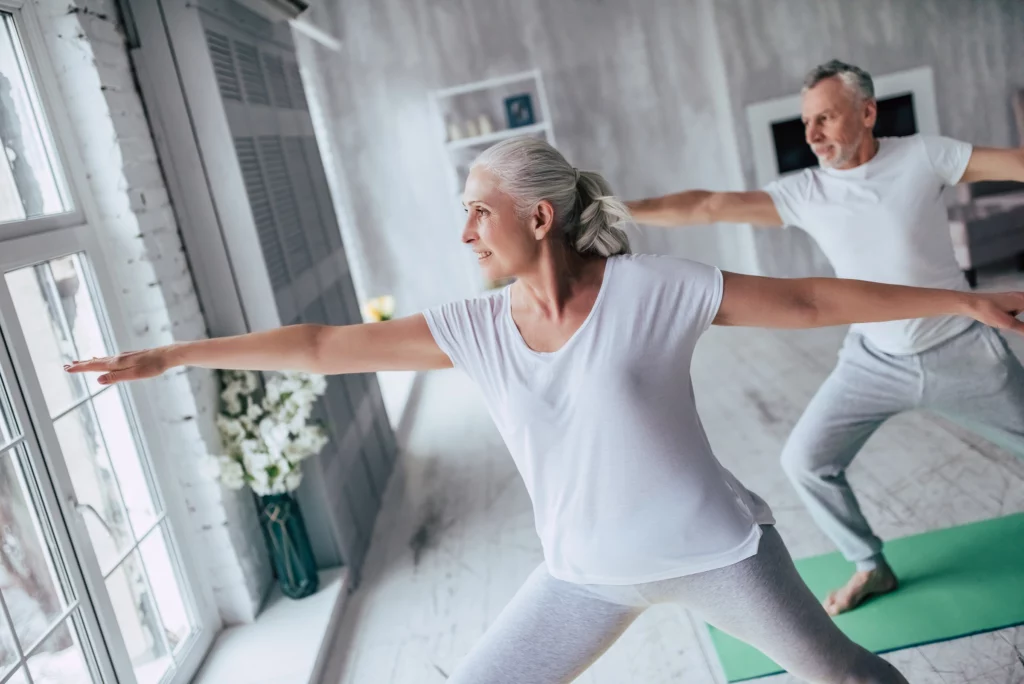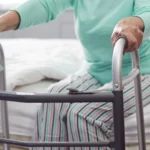
The Importance of Exercise and Physical Therapy for Lewy Body Dementia
This post may contain affiliate links or Google Ads and we may earn a small commission when you click on the links at no additional cost to you. As an Amazon Affiliate, we earn from qualifying purchases. This is at no additional cost to you and helps with our website expenses.

If you have a loved one who has been diagnosed with Lewy Body Dementia (LBD), exercise and physical therapy is one of the most important things you can do to help them manage their symptoms. Physical therapy for Lewy Body Dementia can include a variety of exercises tailored specifically for those with LBD. It can help with balance problems, stiffness, shuffling gait, walking, and motor function.
Additionally, physical therapy can help to improve moods and memory, as well as address visio-spatial issues. Falls are a common problem among those with LBD, so physical therapy also helps to prevent falls. Many different types of exercise and physical therapy can be beneficial for those with LBD – so be sure to discuss options with your doctor or therapist. Regardless of what type of physical therapy or exercise you choose, it is important to keep your loved one active to help them manage their LBD.
What is Lewy Body Dementia and what are the symptoms?
Lewy body dementia (LBD) is a type of progressive dementia that leads to a decline in thinking, reasoning and independent function. Symptoms typically include changes in mood and behavior, delusions, hallucinations and problems with movement. LBD is caused by the buildup of Lewy bodies in the brain. These are abnormal structures that contain proteins that can interfere with brain cells.
Exercise and physical therapy may help to improve the symptoms of LBD by increasing activity levels, improving mental function and reducing stress. In addition, exercise may help to improve sleep quality, which is often impaired in people with LBD. However, it is important to consult with a doctor before starting any exercise program.
How can exercise and physical therapy help those with Lewy Body Dementia?
Exercise and physical therapy can help people with Lewy Body Dementia (LBD) in a number of ways. First, exercise can help to improve overall fitness and reduce the risk of falling. In addition, exercise can help to improve mental function and mood, both of which can be affected by LBD. Finally, exercise can help to reduce the symptoms of hallucinations and delusions, two common features of LBD. Physical therapy, meanwhile, can help to improve coordination and balance, as well as to strengthen the muscles that support the spine. As a result, exercise and physical therapy can play an important role in managing the symptoms of LBD.
What are some of the benefits of exercise and physical therapy for those with Lewy Body Dementia?
Exercise and physical therapy can offer a range of benefits for those with Lewy Body Dementia (LBD). Exercise can help to improve mood, sleep, and overall well-being, as well as reduce feelings of anxiety and depression. it can also help to improve balance and coordination, and increase strength and endurance. For many people with LBD, physical therapy can be an important part of managing the condition.
Physical therapy can help to improve range of motion, flexibility, and balance. It can also help to reduce pain, fatigue, and stiffness. In addition, physical therapy can help to increase strength and endurance. For people with LBD, exercise and physical therapy can be an important part of maintaining a good quality of life.
How can you get started with exercise and physical therapy if you or a loved one has Lewy Body Dementia?
If you or a loved one has Lewy Body Dementia, exercise and physical therapy can be a great way to help manage symptoms and improve quality of life. Exercise can help improve mental sharpness, mood, and balance. Physical therapy can help with movement issues and pain management. Before starting any exercise or physical therapy program, it is important to talk to your doctor to make sure that it is safe for you or your loved one.
There are also a few things to keep in mind when designing an exercise or physical therapy program for someone with Lewy Body Dementia. For example, it is important to start slowly and gradually increase intensity as tolerated. Additionally, breaks should be taken often to avoid fatigue. Finally, it is important to focus on exercises that are enjoyable and that can be done consistently. With these things in mind, exercise and physical therapy can be a great way to help manage symptoms for people with Lewy Body Dementia.
Are there any risks associated?
While exercise and physical therapy are generally considered to be beneficial for patients with Lewy Body Dementia, there are some potential risks associated with these activities. First, patients may experience episodes of delirium or hallucinations during or after exercise, which can be extremely distressing. Additionally, exercise may increase the risk of falls in patients with LBD, due to failing motor control and impaired balance.
Finally, patients with LBD often have difficulty regulating their body temperature, and exercise may exacerbate this problem, leading to dehydration or heat exhaustion. However, these risks should not discourage patients with LBD from participating in exercise or physical therapy; rather, they should be aware of the potential risks and take steps to minimize them. With proper precautions in place, exercise and physical therapy can help patients with LBD improve their quality of life.
What types of exercise or physical therapy are best for Lewy Body Dementia?
With the similarities of Parkinson’s Disease, Parkinsonism, and Lewy Body Dementia many exercises or physical therapies that are good for one are good for all.
Tai Chi
Tai Chi is a form of meditation that involves slow, deliberate movements. It is often practiced for its calming effects and its ability to improve balance and flexibility. For people with Lewy Body Dementia (LBD), Tai Chi can be an especially beneficial form of exercise. People with LBD are at an increased risk of falls. Tai Chi can help to improve balance and coordination, and therefore reduce the risk of falls.
In addition, the slow, deliberate movements of Tai Chi can be soothing and provide a sense of calm for people with LBD. For people who have difficulty standing without assistance, chairs or bars around the person can help keep them safe while they practice Tai Chi.
Here is a Tai Chi video from the American Parkinson Disease Association.
Rock Steady Boxing
Rock Steady Boxing is a non-contact fitness program designed specifically for people with Parkinson’s. The exercises are adapted from the world of boxing, which emphasizes agility, speed, endurance, accuracy, hand-eye coordination, and strength.
The Rock Steady Boxing Program was pioneered in 2006 by Scott Cioffi, a boxing aficionado and certified personal trainer. The program employs applied motor learning to help those with Parkinson’s improve their quality of day-to-day life. Studies have shown that consistent participation in the program leads to improvements in symptoms such as tremor, rigidity, bradykinesia, balance and gait.
Aside from improving physical fitness, Rock Steady Boxing can also help improve mood and cognitive function. The program is offered at various locations internationally. For more information, please visit www.rocksteadyboxing.org today.
Strength Training
Strength training is an exercise that helps increase muscle mass and strength. Conducting this type of training two to three times a week, with low repetitions and weight at first, can be helpful for some people. Focusing on extensor muscles — the kind found in the back of your body — might improve posture. Building up core strength allows better balance while walking, standing and during other activities you do every day.
Overall, strength training can help improve your strength, endurance, and flexibility. Additionally, strength training may also help to improve cognitive function and reduce the risk of falls. Therefore, strength training is a beneficial exercise for people with Lewy Body Dementia to help improve their strength, posture, balance, and cognitive function.
Seated Exercise
For those that have difficulty maintaining balance, standing, or walking, seated exercise routines are a great workout. There are plenty of exercises that can be done seated and vastly improve physical condition. They can even be done with small weights. The American Parkinson Disease Association in St. Louis has videos with complete seated exercise routines.
Some seated exercises require the use of a chair with armrests. Others can be done without armrests. A routine might includes seated leg lifts, arm raises, and vocal exercises. Each routine is different and tailored to the needs of the individual. Seated exercise routines are a great way to stay active and healthy.
Yoga
There are many different types of yoga, but all forms share certain commonalities, such as the use of breathwork, postures (or asanas), and meditation. When it comes to yoga for Lewy Body Dementia, the focus is on gentle movements and stretches that help to increase flexibility, improve posture, and loosen tight painful muscles.
In addition, yoga can help to build (or rebuild) confidence and enhance the quality of life. Yoga can provide significant relief from symptoms and help people manage the disease. As such, it is one of the best exercises for Parkinson’s disease (PD) or Lewy Body Dementia.
Walking
Walking is a great form of exercise for people of all ages, but it can be especially beneficial for those with Lewy Body Dementia. Walking can help to improve motor function, mood, and fatigue, as well as fitness and some aspects of thinking abilities. If your loved one needs to build fitness, start with just a few minutes of walking per day. Together, you can work your way up to additional minutes per day or whatever feels most comfortable.
Plus, walking can help ease some of the anxiety people might have as a caregiver. Some people might need walkers to safely exercise by walking, but regardless, walking is a great way to get started on a fitness journey.
Walking Treadmill with Low Wide Deck and Handrails for Balance
This treadmill is built for seniors and those with balance issues. The deck is low and the handrails make it more safe. It is portable and is easily moved. The console tracks distance, duration and calories burned. Click here for more information.
What should you do if you experience any adverse effects while participating in exercise or physical therapy for Lewy Body Dementia?”
There are a few things that you should keep in mind if you are planning on starting exercise or physical therapy for Lewy Body Dementia. First, it is important to talk to your doctor to make sure that exercise or physical therapy is right for you. Once you have started, be sure to listen to your body and pay attention to how you are feeling. If you experience any adverse effects, such as increased fatigue or dizziness, stop the activity and consult with your doctor. With careful planning and supervision, exercise or physical therapy can be a great way to improve your overall health and well-being.
Though there are some risks associated with exercise and physical therapy for those with Lewy Body Dementia, the benefits seem to far outweigh the risks. Exercise and physical therapy can help improve symptoms, cognition, motor function, mood, quality of life, and even slow the progression of Lewy Body Dementia. If you or a loved one have been diagnosed with LBD, talk to your doctor about starting an exercise program tailored specifically for you. And if you already participate in exercise or physical therapy, keep up the good work! Be sure to report any adverse effects to your doctor immediately.
Do you or your loved one with LBD exercise? Let us know in the comments below!





